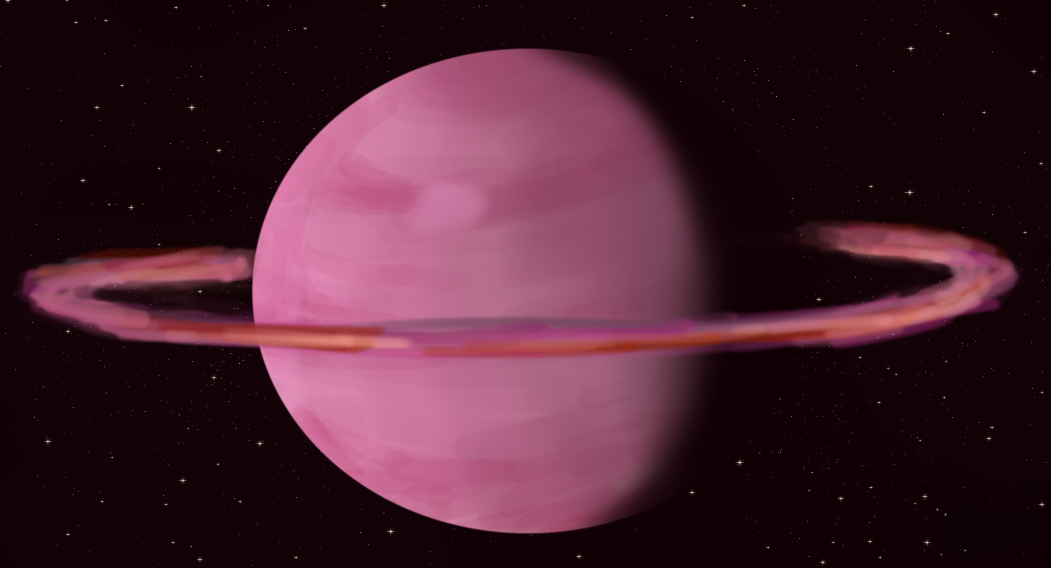Kinosmo System
Kinosmo is a large Solar System containing eight planets: Mercury, Venus, Earth, Mars, Jupiter, Saturn, Uranus, and Neptune.
The eight planets and five dwarf planets all orbit Aquarius, a main sequence star.
Planets
Mercury
- 0 Moons- 0.4 AU from Aquarius
The first planet orbiting Aquarius is Mercury. This tiny planet is very hot, and as a result all of the creatures on the planet live underground. The surface of Mercury is more of a shell, underneath are cave systems that revolve the entire planet, with giant rock pillars holding up the roof.
The Mercurians are a small species, and they live in large sprawling cities along the cave grounds. They have indeed developed space-travel, and are common visitors on many different planets. There is a small population of Mercurians on Karkhala, in the Kurhira Solar System.
Venus
- 0 Moons- 3.9 AU from Aquarius
The second planet orbiting Aquarius, Venus is the hottest planet in the solar system. Only a few plant species grow on Venus, such as the wriggle reeds. These plants spread their seeds for miles, and feed on a unique mineral to any other plant on the planet and have subsequently grown worldwide.
With a record number of sapient species in the solar system at 13, Venus is no stranger varying cultures, architectures, religions and peoples. Any tourist on vacation on Venus must wear proper equipment to deal with the temperatures, but with how advanced technology is that isn't that big of a deal.
Earth
- 1 Moon- 1 AU from Aquarius
Earth is home to more animal and plant species than all the other planets in the solar system, combined. Earth's most prevalent sapient species were humans. Their extinction led to Jupiter's claim over the planet, after losing a war to claim Neptune.
Earth displays a range of biomes, unlike most other planets in the Kinosmo Solar System. Earth has also seen many mass extinctions, such as the Permian Extinction, Triassic Extinction, Jurassic Extinction, Cretaceous extinction, among many others, which has hindered life and technology from progressing.
Mars
- 2 Moons- 1.5 AU from Aquarius
Mars is the fourth planet orbiting Aquarius, and is generally a barren landscape, with few plants. While usually a very cold atmosphere, few locations are warm and that is where you will find life, such as Olympus Mons.
The native sapient species, martians, occupy not just Mars, but Neptune as well. After successfully defeating Jupiter in a war over the planet after the neptunians went extinct, Mars took control of Neptune and its resources, with plans to conquer more planets.
Jupiter
- 131 Moons- 5.2 AU from Aquarius
Jupiter is the largest planet in the Kinosmo Solar System, and is a gas giant. These rare planets rarely contain much life, but surprisingly Jupiter is home to great metropolises constructed thousands of years ago, and continue to increase in size and population.
As one of the most powerful planets and civilisations in this solar system, when Neptune lost its only native species, Jupiter wanted control of the planet and its resources. It lost the battle against Mars for control, but right after humans went extinct, and so Jupiter took immediate control of Earth.
Saturn
- 91 Moons- 9.5 AU from Aquarius
Saturn has gone under the radar for thousands of years, and is widely considered a peaceful planet despite having some of the most torturous and immoral organisations, hidden within the gas giant. Tourists rarely land on Saturn, and currently there are few places to go and visit, as Saturnians strongly dislike foreigners.
To humans Saturn was a gold-mine, or rather, a diamond-mine. Diamonds were one of the most valuable treasures on Earth to humans, and the idea that Saturn rained diamonds on a regular basis made them determined to conquer the planet, which they never did.
Uranus
- 34 Moons- 19.8 AU from Aquarius
Uranus is the seventh planet from Aquarius, and is a very famous planet. Uranus is most famous for their ever increasing population of Uranians. Uranians are most know for their ability to reproduce at alarming rates, and therefore have caused significant over-population on their native planet. Uranians have resorted to space-travel, searching for new planets they can migrate a percentage of their population to, as simply not reproducing isn't an option.
Neptune
- 14 Moons- 30 AU from Aquarius
The eighth and final planet orbiting Aquarius, Neptune is the other of the two Harvesting Planets in the Kinosmo Solar System. Neptune's population of Neptunians died out a few years ago, when the core of the planet heated up a couple degrees warmer, which was enough to wipe out the race of highly adapted Neptunians. A small fleet of Neptunians managed to escaape the planet, but sadly died out when they unwittingly ran into a lordricarr within an Astral Sea.






Comments